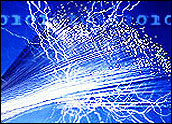
Silicon is the lifeblood of electronics today, but in the photonics world — the world of lasers and fiber optic transport — it has had to play second fiddle to more exotic substances like indium phosphide and gallium arsenide. Researchers, though, are working to change that orchestration and reap the enormous benefits silicon photonics would create for computers and computer networks.
Alcatel-Lucent Bell Labs recently announced a development that appears to bring the marriage of silicon and photonics closer to mainstream reality. What the researchers have done is create a new kind of optical filter on a chip for improving the performance of fiber optic networks.
As a signal travels through an optical network, it loses its fidelity due to a number of factors within the network. “What our filter does is allow us to clean up the signal, to tweak it so it will reflect its true spectral content,” Sanjay Patel, Alcatel-Lucent Bell Labs technical manager for integrated photonics research, told TechNewsWorld.
Novel Architecture
What’s more, the filter can perform its chores totally in the optical realm. Currently, similar network filters have to convert an optical signal into an electrical one to clean it up, then turn it back into an optical signal before sending it on its way. That can slow down a network, Patel observed. “Things are moving at high speeds in optics, and you don’t want to be slowed down by electronics,'” he said.
“This would be a novel filter architecture even if it were made from the typical boutique photonic components,” he observed. “The gravy, though, is that we did this on a new silicon platform. That makes this a milestone.”
Bell Labs’ recent innovation is part of a broader effort by industry and academic researchers to create optics-on-a-chip systems that can take advantage of the existing silicon-based chip manufacturing infrastructure.
“Electronics is a multi-multi-billion industry,” Patel noted. “It’s a real juggernaut, and most of the chips there are built on standard silicon CMOS (complimentary metal oxide semiconductor) technology.
“Then there’s the world of photonics, which is where optical communications lives in,” he continued. “Compared to the silicon juggernaut, it’s boutique operations using a soup of materials. Nothing is high volume; volume is completely fractured across these technologies.”
Hybrid Chips
Just as hybrid cars marry two power sources for a beneficial end, the marriage of two technologies like electronics and photonics can also produce advantages, Patel said.
“Both the electronics and photonics worlds have advantages to them,” he observed. “Wouldn’t it be nice if you could seamlessly switch between the two?
“That means,” he continued, “you need a common platform to build the thing on. That platform is silicon.”
Not only do you benefit from economies of scale when you move to silicon, he argued, but a whole new vista for photonics is opened up.
Devices can be smaller, yet gain greater sophistication, he said. “It opens up a whole new class of structures and architectures, which I just couldn’t imagine doing in the traditional way,” he added.
Faster Web
Silicon photonics may also be a key to improving the speed of the Internet.
Optical systems today use relatively large components, explained Jungsang Kim, an assistant professor in the electrical and computer engineering department at Duke University.
“If you can put everything on a single chip and increase the integration level, you can put a large number of chips in a small device, which consumes much less power,” he told TechNewsWorld. “That can help you process your signal much faster.”
Although researchers are making good progress in paving the way for the migration of photonics to silicon, commercial products are still years away. “My guess is it will be three to five years before you start seeing silicon photonics appearing in networks,” Patel predicted.





















































